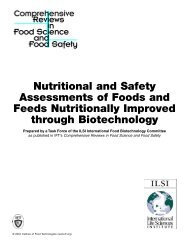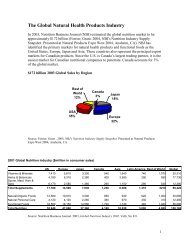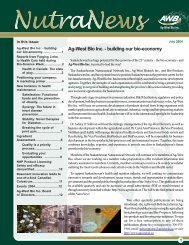Beyond Borders: Global biotechnology report 2010
Beyond Borders: Global biotechnology report 2010
Beyond Borders: Global biotechnology report 2010
Create successful ePaper yourself
Turn your PDF publications into a flip-book with our unique Google optimized e-Paper software.
Longer term, pharma consolidation<br />
inevitably reduces the number of potential<br />
acquirers and collaborators. One only has<br />
to consider the example of Pfizer — which<br />
today is made up of parts of formerly<br />
independent companies such as Wyeth,<br />
American Home Products, Warner<br />
Lambert, Pharmacia, Upjohn and GD<br />
Searle — to see how acquisitions have<br />
thinned the ranks of big pharma over the<br />
last decade. It is also entirely possible that<br />
we are not yet done with the mega-merger<br />
wave. Some of the remaining players,<br />
including those that have not recently<br />
undertaken large acquisitions, could well<br />
turn to consolidation to acquire the scale<br />
needed for absorbing the increasing risk of<br />
drug development.<br />
Finally, most of the mega-transactions,<br />
and many smaller deals undertaken by<br />
the pharmaceutical industry in 2009,<br />
were at least partly based on the strategy<br />
of diversification — whether by market<br />
(e.g., gaining a foothold in emerging<br />
markets), market segment (e.g., consumer<br />
products, generics and animal health)<br />
or technology (e.g., vaccine and biologic<br />
capabilities). These companies will also<br />
increasingly be executing transactions in<br />
the commercial end of the value chain,<br />
including with non-traditional entrants. (For<br />
more on this trend, refer to Ernst & Young’s<br />
<strong>2010</strong> pharmaceutical industry <strong>report</strong>,<br />
Progressions: Pharma 3.0.) Biotech<br />
companies should expect to see more<br />
pharma transactions focused on areas other<br />
than the product pipeline in the future.<br />
The pharmaceutical industry needs a<br />
healthy ecosystem that continues to sustain<br />
innovative <strong>biotechnology</strong> companies and<br />
provide adequate returns to the investors<br />
who nurture this innovation. Just as<br />
investors in early-stage companies are<br />
changing their strategies, big pharma<br />
companies are also experimenting with new<br />
structures to access innovation, increase<br />
their “shots on goal” and share risk.<br />
Bridging the alliance GAAP<br />
In 2009, there were nine strategic alliances<br />
between pharma and biotech companies<br />
with values that could potentially exceed<br />
US$1 billion in the unlikely event that all<br />
milestones are achieved. In these nine<br />
transactions, the pharma partners made upfront<br />
license and other payments totaling<br />
about US$900 million.<br />
Remarkably, seven of the nine transactions<br />
were completed by big pharma companies<br />
headquartered in Europe. This may have<br />
something to do with accounting standards,<br />
Selected 2009 alliances<br />
Company Country Partner Country<br />
since European companies <strong>report</strong> under<br />
International Financial Reporting Standards<br />
(IFRS) which permits the capitalization of<br />
up-front payments (and, generally, follow-on<br />
milestone payments). US-headquartered<br />
companies, on the other hand, must<br />
expense license payments for products<br />
in development when the payments are<br />
made — creating an immediate dent in their<br />
<strong>report</strong>ed earnings per share at a time when<br />
companies are under increasing short-term<br />
earnings pressures.<br />
Everything else being equal, the different<br />
<strong>report</strong>ing standards do provide companies<br />
<strong>report</strong>ing under IFRS more flexibility in<br />
structuring transactions. This does not<br />
mean, of course, that US pharmaceutical<br />
Potential value<br />
(US$m)<br />
Novartis Switzerland Incyte US 1,310<br />
AstraZeneca UK Targacept US 1,240<br />
sanofi-aventis France Exelixis US 1,161<br />
AstraZeneca UK Nektar Therapeutics US 1,160<br />
Bristol-Myers Squibb US ZymoGenetics US 1,107<br />
Takeda Japan Amylin US 1,075<br />
Bristol-Myers Squibb US<br />
Alder<br />
Biopharmaceuticals<br />
US 1,049<br />
GlaxoSmithKline UK Chroma Therapeutics UK 1,008<br />
GlaxoSmithKline UK<br />
Concert<br />
Pharmaceuticals<br />
US 1,000<br />
Johnson & Johnson US Elan Ireland 875<br />
Wyeth US Santaris Pharma Denmark 847<br />
Bayer Schering Germany Algeta Norway 779<br />
Astellas Japan Medivation US 765<br />
Amgen US Array Biopharma US 726<br />
GlaxoSmithKline UK Prosensa Netherlands 668<br />
Source: Ernst & Young, Windhover Information, MedTRACK, BioWorld and company news via NewsAnalyzer<br />
Chart shows potential value, including up-front and milestone payments.<br />
77








